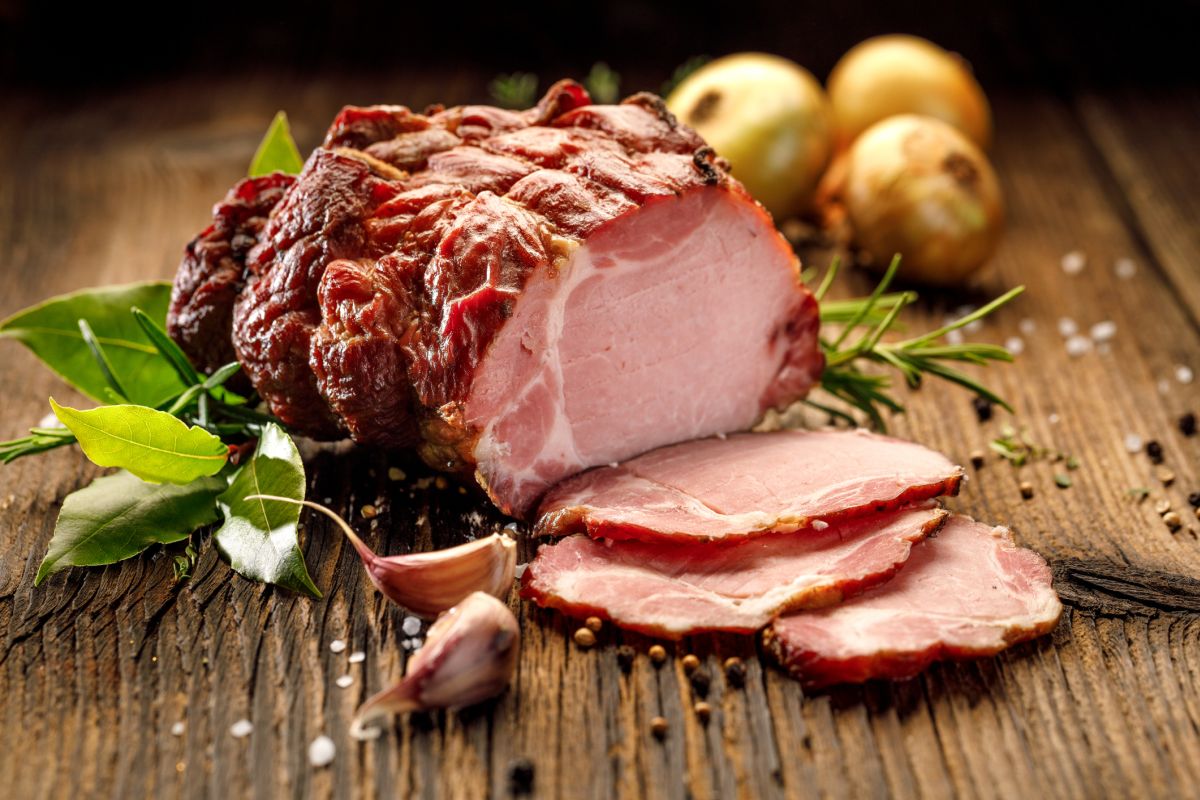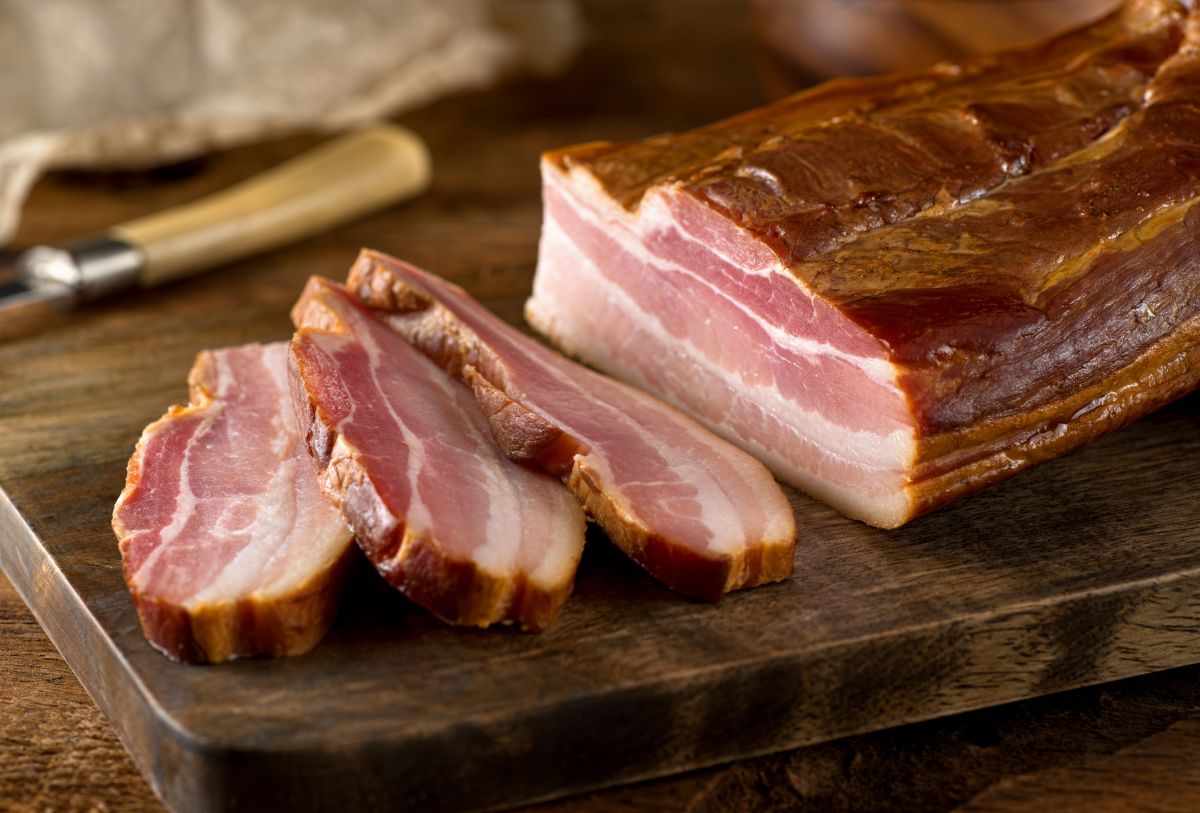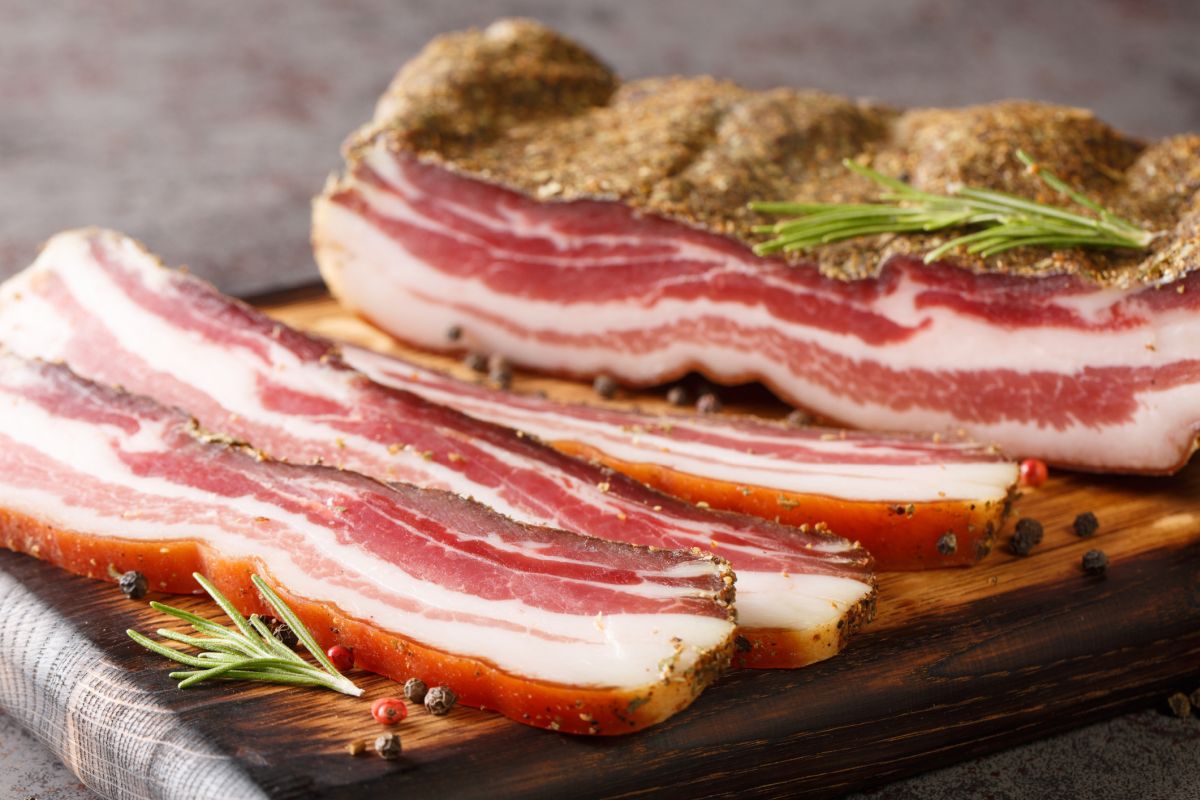When comparing bacon vs. ham, there are a few things to consider. Bacon and ham are both considered to be good sources of protein, but there are differences between the two.
What is Ham?

Cut from the upper thigh, buttock, or the area where the knee meets the thigh, ham is commonly used to make sandwiches and other snacks. Ham can be wet-cured or dry-cured which are two different methods intended to prolong the shelf life of foods like meat, produce, and fish.
Generally, ham is purchased as something ready to eat as it has already been cooked.
Types of Ham
There are multiple types of ham that can be found all around the world. For example, in Italy, cured or cooked ham is known as prosciutto.
Perma ham, also found in Italy, uses a slight amount of salt that is cured by using sugar and garlic powder.
In Spain, serrano ham is made from a white pig. Whereas, in France, wet-cured boneless ham, or Jambon de Paris, is popular.
Tinned ham is the most popular kind of ham in the United States. It is a relatively tiny meat that can be bought in tins.
Health Benefits of Ham
- Ham is rich in protein and it is a lean source of protein. In fact, ham supplies all nine essential amino acids that are beneficial for growth and repair. This protein is considered to be high quality, and it’s an easy form of protein for our bodies to access and use.
- Ham is a source of B vitamins, including B1, B3, and B6.
- Ham is a good source of minerals as it is rich in selenium, zinc, phosphorus, potassium, and iron. Ham may also support bone health, immunity, energy production, and thyroid function.
- Ham is lower in saturated fat than lamb or beef. Mono-saturated fat is the majority of the fat you find in pork, but it does have higher levels of polyunsaturated fats when you compare it to other kinds of red meat.
- Ham is rich in energizing ingredients. It is a key source of nutrients such as iron, vitamin B12, carnosine, choline, and co-enzyme Q10.
Ham Disadvantages
Ham may increase a person’s risk for cancer. Along with other processed meats, ham is classified by the International Agency for Cancer Research as carcinogenic.
This means that there is sufficient evidence to indicate that consuming ham can potentially cause colorectal cancer. It is suggested to limit the consumption of ham and other red meats to no more than three portions a week.
Ham may increase the risk of heart disease according to some research. One study analyzed the diets of over 40,000 people and found that people who eat processed and/or unprocessed red meat may be at an increased risk of coronary heart disease. This might be explained by red meat containing saturated fat.
Eating ham or other red meat may affect life expectancy. One study found that increased consumption of red meat led to a higher risk of death.
Common Uses For Ham
Ham is often used in its sliced form, such as in a ham and cheese sandwich. However, ham can be used in a variety of dishes and is also a popular dish for certain holidays like Christmas or Thanksgiving.
What is Bacon?
Bacon is made from the remaining side of the pig after the head and feet have been removed. In the United States, bacon is often made from pig bellies.
Types of Bacon
- Known as pancetta in Italy, pancetta is uncooked cured bacon strips. These cured bacon strips have a coating of fat.
- Jowl bacon is made from pig cheeks. It is cured and smoked.
- Popular in the United Kingdom and Ireland, gammon is made from the pig’s back leg and it is usually ‘Wiltshire cured.’
- Cottage bacon is made from the shoulder, and cottage bacon is very thin and chopped into oval patterns.
- Streaky bacon comes from the pig’s belly. ‘Streaks’ refers to the fat that is running through each slice or rasher.
Bacon Health Benefits
Consuming bacon may boost a person’s energy as it proved six of the eight B vitamins that are vital for brain and energy function. Bacon is also a good dietary fat source, which provides energy and promotes satiety.
For some, high-sodium foods like bacon can be beneficial to people who need help with getting more salt in their diet. This can be the case for athletes, who sweat out high amounts of salt, which can lead to an electrolyte imbalance.
Disadvantages of Bacon
- Bacon is high in salt as salt is used during the curing process. Eating food with a high salt content has been linked to an increased risk of stomach cancer. Excessive salt intake can also increase blood pressure for those who have salt sensitivity.
- Since bacon is processed meat, it contains additives like nitrates and nitrites. When these additives are over high heat, this causes nitrosamines compounds to form which are known carcinogens. While bacon contains much less nitrosamine than it did in the past, there is concern that high bacon intake may increase the risk of cancer.
- Bacon can potentially have more harmful compounds if overcooked or undercooked. You need to cook meat well enough so that harmful compounds like polycyclic aromatic hydrocarbons and heterocyclic amines don’t form. These compounds have been associated with cancer. On the other hand, you want to make sure to kill potential pathogens like bacteria, parasites, and viruses.
Bacon Common Uses
Bacon can be eaten as a side dish, which is particularly popular while eating breakfast. It can also be used as a flavoring or as an accent to other foods, such as bacon bits in a salad.
In addition, bacon can also be used as a central ingredient, like in a BLT sandwich, or in a bacon cheeseburger.
Bacon vs. Ham: How Are They Similar?
Ham and bacon are cuts of meat that are taken from a pig. Both are full of nutrients and are popular foods to eat.
Key Differences: Bacon vs. Ham
Cut of the Meat
Bacon is often cut from the rear of the pig or the ribs. In the United States, pig belly is also used to create bacon. Ham, on the other hand, is cut from the upper thigh, buttock, or the area where the thigh meets the bone.
Preparation
Bacon can be cured in brine or buried in a dry packing. The dry packing contains large amounts of salt. Bacon can be smoked, boiled, or dried in cold air. Ham is typically smoked once it has been cured. It is often wet or dry cured with sugar and honey.
Ways of Eating
Bacon can be fried, smoked, boiled, baked, or grilled. Ham is typically consumed when it is sliced.
Bacon bits are sometimes used as a topping for a variety of dishes, such as pizza and salad. Bacon may also be wrapped around other kinds of meat, such as chicken breast.
Taste
Ham has more moisture than bacon, while bacon is more crispy.
Bacon vs. Ham Nutritional Value
| Ham | Bacon | |
| Calories | 69 calories per slice | 43 calories per slice |
| Carbohydrates | 1.5 grams for every 100 grams | None. |
| Saturated Fat | 7.2 grams of saturated fat | 32 grams of saturated fat content for every 100 grams |
| Cholesterol | Contains 60 milligrams for every 100 grams | Contains 97 milligrams of cholesterol for every 100 grams |
| Vitamin A | No significant levels of vitamin A for every 100 grams | Regular bacon contains 11 micrograms of vitamin A for every 100 grams |
| Protein | 21 grams for every 100 grams | 37 grams of protein for every 100 grams |
| Vitamin D | 26 IU of vitamin D for every 100 grams | No vitamin D |
| Vitamin E | Contains 0.27 milligrams for every 100 grams | No vitamin E |
| Vitamins B and C | Higher levels of thiamin, niacin, riboflavin, pantothenic acid, vitamin B12, and vitamin B6. | Lower levels of vitamins B and C |
| Calcium | 10 milligrams of calcium for every 100 grams | 1 milligrams of calcium for every 100 grams |
| Iron | 0.79 milligrams of iron for every 100 grams | 0.13 milligrams of iron for every 100 grams |
| Potassium | 311 milligrams for every 100 grams | 15 milligrams of potassium for every 100 grams |
Which is the Healthier Choice: Bacon vs. Ham
Ham and bacon provide many nutritional benefits. The best ham and bacon to consume are considered to be non-GMO and clean. It’s also best if it’s unadulterated meats, meaning that there are no hormones and antibiotics.
In general, nutritionists have shown concern regarding the health effect of bacon, ham, and other processed meets. Many studies have associated a high intake of processed meat to be correlated with heart disease and cancer. Because of this, it’s best to eat bacon or ham in moderation.


Leave a Reply